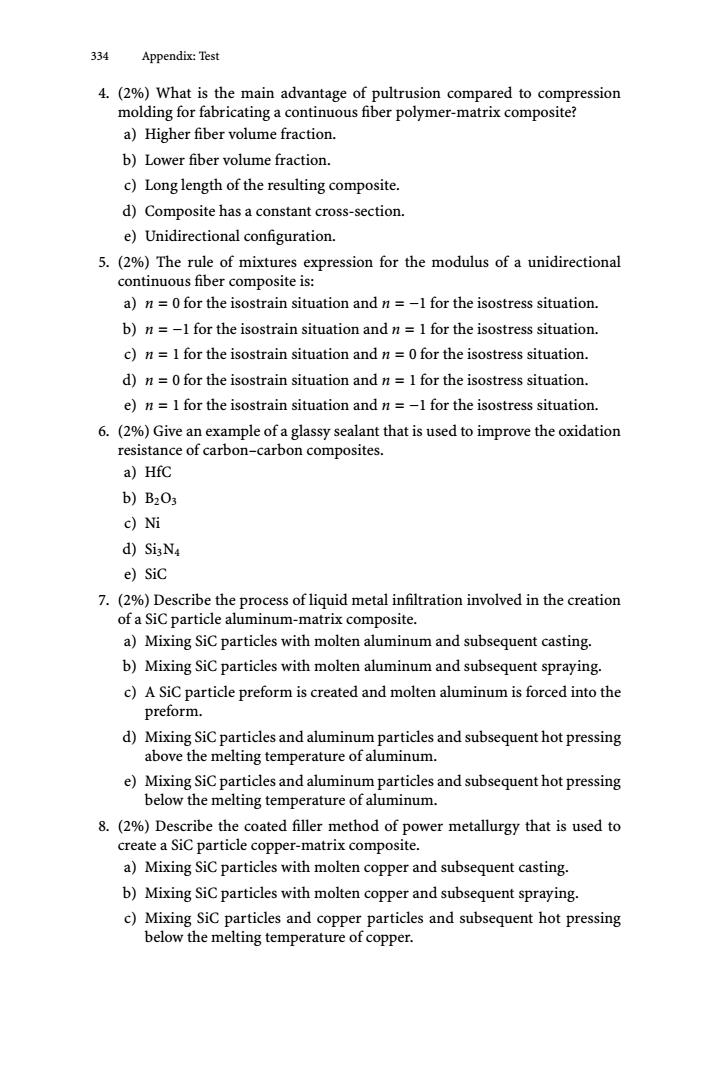正在加载图片...

334 Appendix:Test 4.(2%)What is the main advantage of pultrusion compared to compression molding for fabricating a continuous fiber polymer-matrix composite? a)Higher fiber volume fraction. b)Lower fiber volume fraction. c)Long length of the resulting composite. d)Composite has a constant cross-section. e)Unidirectional configuration. 5.(2%)The rule of mixtures expression for the modulus of a unidirectional continuous fiber composite is: a)n=0 for the isostrain situation and n =-1 for the isostress situation. b)n=-1 for the isostrain situation and n 1 for the isostress situation. c)n=1 for the isostrain situation and n =0 for the isostress situation. d)n =0 for the isostrain situation and n =I for the isostress situation. e)n=1 for the isostrain situation and n =-1 for the isostress situation. 6.(2%)Give an example of a glassy sealant that is used to improve the oxidation resistance of carbon-carbon composites. a)HfC b)B203 c)Ni d)SisN4 e)SiC 7.(2%)Describe the process of liquid metal infiltration involved in the creation of a SiC particle aluminum-matrix composite. a)Mixing SiC particles with molten aluminum and subsequent casting. b)Mixing SiC particles with molten aluminum and subsequent spraying. c)A SiC particle preform is created and molten aluminum is forced into the preform. d)Mixing SiC particles and aluminum particles and subsequent hot pressing above the melting temperature of aluminum. e)Mixing SiC particles and aluminum particles and subsequent hot pressing below the melting temperature of aluminum. 8.(2%)Describe the coated filler method of power metallurgy that is used to create a SiC particle copper-matrix composite. a)Mixing SiC particles with molten copper and subsequent casting. b)Mixing SiC particles with molten copper and subsequent spraying. c)Mixing SiC particles and copper particles and subsequent hot pressing below the melting temperature of copper.334 Appendix: Test 4. (2%) What is the main advantage of pultrusion compared to compression molding for fabricating a continuous fiber polymer-matrix composite? a) Higher fiber volume fraction. b) Lower fiber volume fraction. c) Long length of the resulting composite. d) Composite has a constant cross-section. e) Unidirectional configuration. 5. (2%) The rule of mixtures expression for the modulus of a unidirectional continuous fiber composite is: a) n = 0 for the isostrain situation and n = −1 for the isostress situation. b) n = −1 for the isostrain situation and n = 1 for the isostress situation. c) n = 1 for the isostrain situation and n = 0 for the isostress situation. d) n = 0 for the isostrain situation and n = 1 for the isostress situation. e) n = 1 for the isostrain situation and n = −1 for the isostress situation. 6. (2%) Give an example of a glassy sealant that is used to improve the oxidation resistance of carbon–carbon composites. a) HfC b) B2O3 c) Ni d) Si3N4 e) SiC 7. (2%) Describe the process of liquid metal infiltration involved in the creation of a SiC particle aluminum-matrix composite. a) Mixing SiC particles with molten aluminum and subsequent casting. b) Mixing SiC particles with molten aluminum and subsequent spraying. c) A SiC particle preform is created and molten aluminum is forced into the preform. d) Mixing SiC particles and aluminum particles and subsequent hot pressing above the melting temperature of aluminum. e) Mixing SiC particles and aluminum particles and subsequent hot pressing below the melting temperature of aluminum. 8. (2%) Describe the coated filler method of power metallurgy that is used to create a SiC particle copper-matrix composite. a) Mixing SiC particles with molten copper and subsequent casting. b) Mixing SiC particles with molten copper and subsequent spraying. c) Mixing SiC particles and copper particles and subsequent hot pressing below the melting temperature of copper